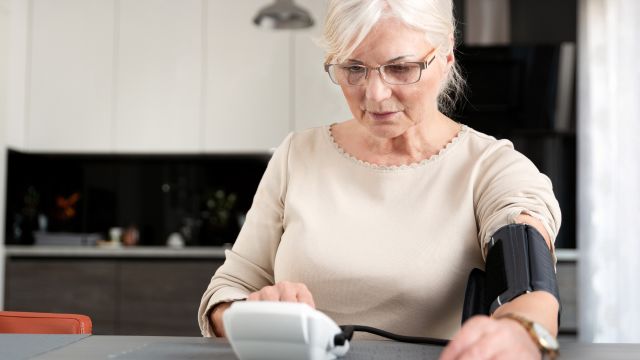Most people will have high blood pressure at some point in their lives. In fact, it's estimated that among people who have normal blood pressure at age 55, 90 percent will develop high blood pressure later on. But you can help keep your RealAge younger by monitoring your blood pressure, learning how to read your blood pressure numbers and getting the treatment you need if they’re consistently high.
Why blood pressure monitoring is important
High blood pressure is a significant risk factor for heart attack, stroke, kidney disease and vision loss. It often is referred to as the “silent killer” because it rarely causes any symptoms until considerable organ damage has occurred. That's why getting regular, accurate blood pressure readings are vital to your long-term health.
Learn more about the effects of high blood pressure on the body.
But what if the measurements you rely on are imprecise? Could inaccurate readings be putting your health at risk? It's possible.
Imprecise measurements, even those that are off by just a few points, can lead to inappropriate treatment. If your numbers are falsely low, you may not receive vital medication that, in the long run, could save your life. Conversely, if your blood pressure numbers are falsely high, you may be given medication you don't really need.
Why readings may be off
You might be surprised at how easy it is to influence the accuracy of such a seemingly simple tool as the blood pressure monitor. Several factors, such as talking (answering a nurse's question) or having a full bladder (because you thought you might be asked to give a urine sample), can temporarily change your blood pressure enough to result in false high or low blood pressure numbers.
And operator error—even at the doctor's office—is one of the leading causes of inaccurate measurements. Studies of healthcare professionals consistently show that doctors and nurses rarely follow recommended guidelines for accurate blood pressure monitoring. And measurements taken casually, without following standard procedures, produce unreliable results.
How did your last test go?
So, how precise was your most recent blood pressure reading? Think back to the last time you had your blood pressure measured, whether it was at the doctor's office, on a machine in the pharmacy, or at home, using a self-monitoring device.
1. Were you sitting quietly for 3-5 minutes prior to your blood pressure being taken?
Blood pressure can be affected by anxiety and movement—even walking could increase your reading 5 to 14 points—so one of the recommended guidelines for getting an accurate measurement is that you sit and relax for 3 to 5 minutes before a blood pressure reading is taken. But in a busy healthcare setting, this doesn't always happen. In one study, only 4 percent of healthcare professionals followed this procedure.
If you're self-monitoring, it's easy to rush the process as well. Slow down and take the time to get it right.
2. Was the cuff size appropriate for your arm?
An appropriate-sized cuff—the part of the monitor that wraps around your arm—is essential for an accurate blood pressure reading. Using a cuff that is too small for your arm will overestimate your blood pressure, and one that is too big will underestimate it. Still, many clinicians use one standard-sized cuff for all patients.
If you're monitoring your numbers with a home device, make sure the cuff you have is the right size for your arm. Read on to learn more.
3. Was your blood pressure measured in both arms?
In some people, there is a significant difference in blood pressure numbers between their right and left arm. Sometimes, differences of 15 points or more can be a sign of a blockage in the aorta or other blood vessel. Although the reason for this is unclear, guidelines recommend that blood pressure be measured in both arms at the initial consultation. If there is a significant difference between the two readings, the arm with the higher reading should be used for future monitoring.
4. Were two measurements taken a few minutes apart?
A single measurement does not provide an accurate assessment of your blood pressure. For more reliable results, at least two readings should be taken a few minutes apart, and the average of the readings should be recorded.
5. During the reading, was your arm supported and resting at heart level, with both feet flat on the floor?
Both body and arm position can influence blood pressure during monitoring, so it's important to follow the guidelines. For the most accurate results, you should be sitting comfortably in a chair with a backrest (not on the examination table) with your feet flat on the floor, legs uncrossed. Your arm should be supported and resting at heart level.
You may also want to do the following:
- Wear short sleeves. The cuff needs to fit snuggly around your bare upper arm, so short sleeves are your best bet. Rolled up long sleeves may constrict your arm, which could alter your blood pressure reading.
- Skip the drinks. Avoid caffeine, cigarettes and alcohol for at least 30 minutes before you measure. They can cause a temporary increase in blood pressure.
- Use the restroom. A full bladder can affect the accuracy of your reading.
- Sit and rest quietly for a few minutes. It's best to sit someplace quiet, where you feel relaxed. This may not be possible when you're at the doctor's office, but if you're at home, it's worth taking the time to get it right. And during your reading, try not to talk or move about.
- Don't speak. Talking during your exam can up your numbers 10 points.
Now that you know how to get the right reading, learn how these 15 foods can help keep your blood pressure under control.
Medically reviewed in November 2019.






